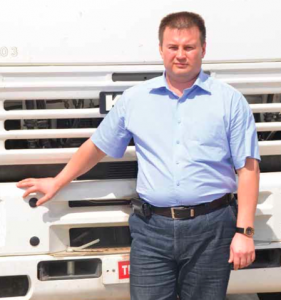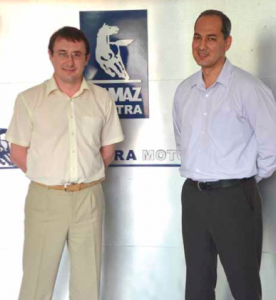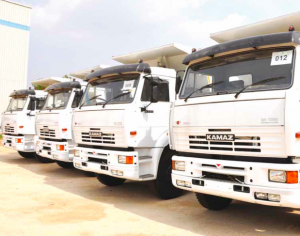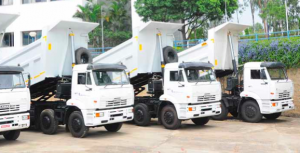 Kamaz Vectra Motors Ltd. (KVML) is all set to enter serial production in the coming year and establish its presence in the Indian market.
Kamaz Vectra Motors Ltd. (KVML) is all set to enter serial production in the coming year and establish its presence in the Indian market.
Mr. Alexey B. Agibalov, CEO, KVML, told Motorindia all about the companyís experience in the Indian market over the last two years and its strategy for the coming years. Kamaz considers India as one of its most important markets for growth and expansion, with its sole commitment to it.
Kamaz, the market leader in Russia, has decades of experience in producing trucks and is focussed on high tonnage, high capacity trucks and heavy commercial vehicles. The company is high on confidence that a similar product will succeed in the Indian market. Though such a segment is not popular in India, Kamaz is keen on creating such a segment.
The company has a manufacturing facility in Hosur and has been testing its trucks on the Indian roads since two years. The plant has a capacity of rolling out 5,000 trucks annually. In the last two years, Kamaz has done a thorough study of, and research into the Indian market to study its potential. ìThe basic result from our market study is that we are adapting our product to the domestic market, taking into consideration all local conditions. Specifically, we are strengthening the frame, changing the filtering system, reworking for the vehicle to be operated in mines. Over 30 modifications have been made in both models ñ 6540 and 6520î, said Mr. Agibalov.
 Kamaz will begin serial production of its products in April. It is confident that the modifications made in its products would prove successful. ìFor the past two years, we ran our product 6540. For next yearís business plan, we have included all modifications as per our experience in the past two years. We will be giving the same product with all modifications, and it will be a completely different new vehicleî, he added.
Kamaz will begin serial production of its products in April. It is confident that the modifications made in its products would prove successful. ìFor the past two years, we ran our product 6540. For next yearís business plan, we have included all modifications as per our experience in the past two years. We will be giving the same product with all modifications, and it will be a completely different new vehicleî, he added.
Kamazís 6520 model has also been undergoing trial in the Indian market, and this year serial production of the model will commence. The 6520 model will be Kamazís flagship vehicle and will be the base of the companyís activities in India. The model will form 60-70 per cent of the basic product portfolio while 20-30 per cent will be the 6540 model which is the modified vehicle. Kamaz is also planning to introduce one more product in the Indian market ñ the tow tractor 6460.
The company targets a production volume of 1,000 vehicles this year which would be an acid test for its production system, sales system and, most importantly, the service system. ìWe donít expect this year to be very easy, but we are very much ready to face the challenge. From next year, we will keep increasing our production volumeî, he added.
Kamaz has set a target of producing 3,000 vehicles within the next five years and later 5,000 vehicles. Kamaz has also got a good understanding of the Indian market, thanks to its extensive market study.
Mr. Agibalov commented: ìThere is huge amount of sales of cheaper products in the Indian market and the components are also cheap. We have also observed vehicles with very light axles with low tonnage, not-so-powerful engines and little comfort for the driver to drive.î
 The company has identified a gap between the low-cost and high-cost vehicles in India and is looking to position its products in that intermediate segment. Kamaz products would be priced slightly higher than the low-cost segment but would come with better working capacity and characteristics, providing more comfort for the driver.
The company has identified a gap between the low-cost and high-cost vehicles in India and is looking to position its products in that intermediate segment. Kamaz products would be priced slightly higher than the low-cost segment but would come with better working capacity and characteristics, providing more comfort for the driver.
Kamazís product range will have trucks from 30T and above. The company is also considering different tonnage capabilities for the future. It has tipper bodies of 16 and 18 m3 capacity and has observed that the market demand is for tippers with capacity greater than 18 m3. The company is working on expanding its product offering to cater to the growing needs of the market.
Kamaz vehicles come with a powerful engine in the range of 280-360 hp which would enable installation of large tipper bodies on the vehicle. The standard vehicles would come with a 9-speed transmission with a 16-speed option available if required by the customer. The company is also prepared to offer a customised design if demanded by the customer, showing its commitment to customer satisfaction. With respect to component suppliers, the company is open to multiple suppliers for all components, with the choice of supplier influenced by market demand.
 The company considers localisation as one of the key aspects of its strategy for the Indian market. ìOne of our strategic targets would be to completely localise the products here. We are in the stage of preparing prototypes, and within two years, we would localise the frame, axles and transmissions. The tipper body has already been completely localised, made by Hyva. The engines will be from Kamaz, Russia, but we will always consider adaptability of the Indian Cummins engine to our products if our customer demands itî, he stated.
The company considers localisation as one of the key aspects of its strategy for the Indian market. ìOne of our strategic targets would be to completely localise the products here. We are in the stage of preparing prototypes, and within two years, we would localise the frame, axles and transmissions. The tipper body has already been completely localised, made by Hyva. The engines will be from Kamaz, Russia, but we will always consider adaptability of the Indian Cummins engine to our products if our customer demands itî, he stated.
On financial terms also, 2012 promises to be an important one for Kamaz. The company is confident of achieving breakeven in the financial year April 2012 to March 2013. Its main target at present is to stay firm in the Indian market. Once its target of 5,000 vehicles is reached, then the companyís export plans would unfold.
Kamaz is planning to train its drivers on working with 16-speed and higher transmissions and economising fuel consumption during operation with the help of ZF. The company is also keen on conducting large programmes for creating dealers and service centres across the country, with a view of having a multiple dealers in each state.
The company wants its customers to have the option of choosing from many dealers in the same location, which again boosts customersí confidence on the Kamaz brand. 2012 promises to be the defining year for Kamaz, and if all goes well, the Russian market leader is sure to make a mark in the competitive Indian commercial vehicle space.